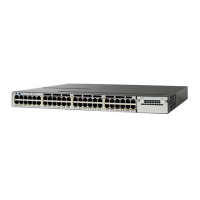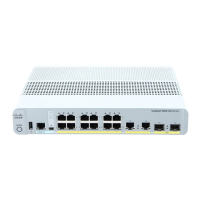Auto-QoS configures the device for connectivity with a trusted interface. The QoS labels of incoming packets
are trusted. For nonrouted ports, the CoS value of the incoming packets is trusted. For routed ports, the DSCP
value of the incoming packet is trusted.
To take advantage of the auto-QoS defaults, you should enable auto-QoS before you configure other QoS
commands. You can fine-tune the auto-QoS configuration after you enable auto-QoS.
The device applies the auto-QoS-generated commands as if the commands were entered from the
command-line interface (CLI). An existing user configuration can cause the application of the generated
commands to fail or to be overridden by the generated commands. These actions occur without warning.
If all the generated commands are successfully applied, any user-entered configuration that was not
overridden remains in the running configuration. Any user-entered configuration that was overridden can
be retrieved by reloading the device without saving the current configuration to memory. If the generated
commands fail to be applied, the previous running configuration is restored.
Note
After auto-QoS is enabled, do not modify a policy map or aggregate policer that includes AutoQoS in its name.
If you need to modify the policy map or aggregate policer, make a copy of it, and change the copied policy
map or policer. To use the new policy map instead of the generated one, remove the generated policy map
from the interface, and apply the new policy map.
To display the QoS configuration that is automatically generated when auto-QoS is enabled, enable debugging
before you enable auto-QoS. Use the debug auto qos privileged EXEC command to enable auto-QoS
debugging.
The following policy maps and class maps are created and applied when running the auto qos classify and
auto qos classify police commands:
Policy maps (For the auto qos classify policecommand):
•
AutoQos-4.0-Classify-Police-Input-Policy
•
AutoQos-4.0-Output-Policy
Class maps:
•
AutoQos-4.0-Multimedia-Conf-Class (match-any)
•
AutoQos-4.0-Bulk-Data-Class (match-any)
•
AutoQos-4.0-Transaction-Class (match-any)
•
AutoQos-4.0-Scavanger-Class (match-any)
•
AutoQos-4.0-Signaling-Class (match-any)
•
AutoQos-4.0-Default-Class (match-any)
•
class-default (match-any)
•
AutoQos-4.0-Output-Priority-Queue (match-any)
•
AutoQos-4.0-Output-Control-Mgmt-Queue (match-any)
•
AutoQos-4.0-Output-Multimedia-Conf-Queue (match-any)
•
AutoQos-4.0-Output-Trans-Data-Queue (match-any)
•
AutoQos-4.0-Output-Bulk-Data-Queue (match-any)
Command Reference, Cisco IOS XE Everest 16.5.1a (Catalyst 3650 Switches)
603
auto qos classify
